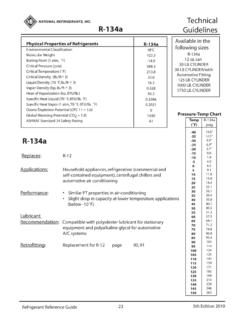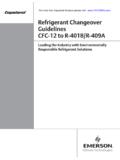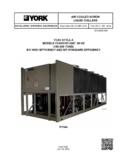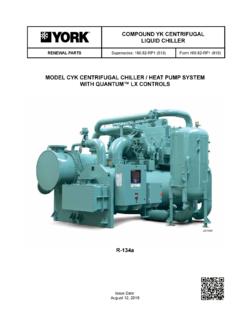Transcription of MATERIAL SAFETY DATA SHEET - Ragnarssons …
1 1 of 5 MATERIAL SAFETY data SHEET Prepared to Commission Directive 1907/2006 (REACH) and US OSHA Standards data SHEET No: MSDS0066UK Issue No: 10 Date: 03/06/09 WHAT IS THE PRODUCT AND WHAT INFORMATION IS REQUIRED IN AN EMERGENCY? SECTION 1 IDENTIFICATION OF SUBSTANCE AND OF THE COMPANYP roduct Name:SOLO Aerosol Smoke Detector Tester Part Number:SOLO A3 XXX; SOLO A4 XXX Manufacturer:No Climb Products Ltd, Edison House, 163 Dixons Hill Road, Welham Green, Hertfordshire, AL9 7JE, UK Tel +44 (0) 1707 282760; Fax +44 (0) 1707 282777 SECTION 2 HAZARD IDENTIFICATIONOVER-EXPOSURE:The most significant route of exposure for this product is by inhalation, eye or skin contact: Inhalation: Inhalation of vapour mists or sprays of this product can cause mild to moderate irritation of the tissue of the nose, throat and upper respiratory system.
2 Over-exposure (as a result of using several cans in a short period of time in a poorly ventilated area) can lead to headache, nausea, general anaesthetic effects and could result in an oxygen-deficient atmosphere due to the vapours of the spray being a lot heavier than air. Skin and eyes: Eye contact with the spray may cause mild irritation; Sustained spraying directly onto skin may cause localised rapid cooling of tissue resulting in frostbite type symptoms. FIRE AND EXPLOSION HAZARDS: This product is classed as a non-flammable aerosol; As with all pressurised aerosol containers, cans may burst if heated to over 50oC (122oF). SECTION 3 COMPOSITION/INFORMATION ON COMPONENTSC omponents CAS No.
3 Approx. wt. % EC Risk phrase/class Mixture of alcohols Mixture 1-20 R36, R11, F HFC 134a (1,1,1,2- Tetrafluoroethane) %Flammable components 811-97-2 Mixture 80-99 C20% None WHAT SHOULD BE DONE IF A HAZARDOUS SITUATION OCCURS? SECTION 4 FIRST AID MEASURESEyes: Lifting eyelids, flush with plenty of water; Obtain medical assistance if irritation persists; Skin: Wash with soap and water; If irritation persists, seek medical attention; Ingestion: Unlikely to happen as the product is a vapour/mist at room temperature; If product enters mouth, rinse mouth out with water and avoid swallowing; Inhalation: Get to supply of fresh air; If irregular breathing occurs, qualified personnel should administer artificial respiration; Seek medical assistance if symptoms persist.
4 2of5 SECTION 5 FIRE FIGHTING MEASURESU nusual Fire and Explosion hazards: Under the normal conditions of use and when subjected to various flame/explosion tests defined by the relevant EC Directives and US DOT criteria, this product does not readily support combustion and is as such, classed non-flammable. However, it does contain a maximum of 20% flammable substances. Consequently, the product may present a slight flammability hazard if the canisters are involved in a fire or the flammable components fractionate (through a leak), producing compositions that are flammable. Extinguishing Media: For large fires, use alcohol resistant foam, CO2or dry chemical powder; Unsuitable Extinguishing Agent: Water with full jets; Special Fire Fighting Procedures: Use water sprays to keep containers that are near a fire cool and vapours down; Move cans way from fire area if it can be done without risk to personnel; Fire fighters must wear self-contained breathing apparatus to guard against being overwhelmed by the products of combustion.
5 Special exposure hazards: None. SECTION 6 ACCIDENTAL RELEASE (SPILL AND LEAK) MEASURES:Person-related SAFETY precautions: With uncontrollable releases ( , release from several cans at once), evacuate affected area and ventilate; Environmental Protection: Prevent run-offs from entering public watercourses; Measures for cleaning: Ensure adequate ventilation to allow for evaporation of volatile components; Eliminate all sources of ignition before spill clean-up begins; Monitor area for combustible vapours and the level of oxygen; Absorb any remaining liquid components with liquid binding MATERIAL and place in suitable container. HOW CAN HAZARDOUS SITUATIONS BE PREVENTED FROM OCCURRING?
6 SECTION 7 PRECAUTIONS FOR SAFE HANDLING, STORAGE & USESafe handling: Good practices include keeping product away from heat, sparks and other ignition sources; Contents are under pressure- do not puncture or force open cans even when empty- cans may contain residual liquid or vapours which may be flammable; Safe Storage: Observe official regulations on storing packaging with pressure containers; Store containers in cool, dry locations away from direct sunlight and do not store at temperatures exceeding 50oC (122oF) ( passenger or back seat of a car in summer months); Do not store together with strong acids or oxidising agents; Safe Use: As with all chemicals, avoid getting this product IN YOU- do not eat and drink whilst handling chemicals; Ensure good ventilation/mechanical exhaustion at workplace- if this is not possible, take regular breaks from use; Do not deliberately concentrate or inhale vapours; Follow label directions carefully; use only with SOLO dispenser.
7 3of5 SECTION 8 EXPOSURE CONTROLSO ccupational Exposure LimitFHFC 134a (1,1,1, 2- Tetrafluoroethane) 1000ppm / 4240mg / m3(8hr TWA reference period). Respiratory Protection: No protective device is required during normal use of product; Mechanical ventilation is recommended where product is used in confined spaces- if this is not possible, take regular breaks in fresh air. Personal Protection: Wear PPE (personal protective equipment) appropriate to the task and the environment. SECTION 9 PHYSICAL AND CHEMICAL PROPERTIESP hysical & Chemical properties:The following information is for 1,1,1,2- Tetrafluoroethane, the main component of this product: Vapour density (air = 1) kg/m3( lb/ft3)Solubility in water (25oC, 77 oF) wt Melting point -101oC ( oF) Boiling point (760 mm Hg) ( oF) Flash point Non-flammable Vapour pressure (20oC, 68 oF) 70 psig The information given immediately below is pertinent to the aerosol product as a whole: Form: Aerosol (liquid released under pressure); Colour: Colourless, clear; Residue formation: Clean, non-greasy, fast evaporating; Odour: Faint sweet pleasant odour.
8 Pressure @20oC (68 oF) ~6 bar (~ 87 psig); @ 50oC (122 oF)~11 bar (~159 psig); Product Density @20oC (68 oF)~ g/ml ( lb/ft3); Flashpoint of liquid 12oC (~ 54 oF); Vapour density (air = 1) Greater than 1; Solubility in water Partly miscible; Aerosol flammability Not flammable; Not self-igniting. SECTION 10- STABILITY & REACTIVITYS tability: Product is stable between 0 and 40oC (32 - 104 oF) and atmospheric pressures; Conditions to avoid: Extreme heat, direct sunlight; Materials to avoid: Strong oxidisers, strong acids, bases, alkali metals; Hazardous decomposition products: On ignition, this product will decompose to produce oxides of carbon; WHAT IS THE IMPACT OF THIS PRODUCT ON HEALTH AND THE ENVIRONMENT?
9 SECTION 11 +TOXICOLOGICAL INFORMATIONU nder normal usage, this product should pose little risks to the health of the user. PRIMARY IRRITANT EFFECT:Skin, Eyes and Respiratory system: Irritant effect through absorption and rapid evaporation of liquid. ACUTE TOXICITY: Over-exposure to this product can moderately irritate skin, eyes and mucus membranes; Inhalation over-exposure in poorly ventilated environments may cause nausea, headache, vomiting and general loss of co-ordination. 4of5 CHRONIC TOXICITY: Similarly, repeated inhalation over-exposure in poorly ventilated environments may cause some respiratory disorders such as pharyngitis; Pre-existing medical conditions in liver, kidney and heart may be aggravated by repeated over-exposure.
10 Additional information: 8 hr TWA (time weighted average) OEL (occupational exposure limit)UK for HFC 134a : 1000 ppm SECTION 12 ECOLOGICAL INFORMATIONE nvironmental Mobility: Over 90% of the product is volatile and is expected to dissipate rapidly into well ventilated areas; the rest is water soluble and will remain primarily in water; Environmental Degradability: This product biodegrades rapidly once in the environment; The propellants do not contain chlorine, are readily degradable in the troposphere and do not deplete the ozone. Eco-toxicity: Low acute toxicity to aquatic life is expected. There is no data for long term adverse effects on aquatic life. Other information:GWP 100 yr.







